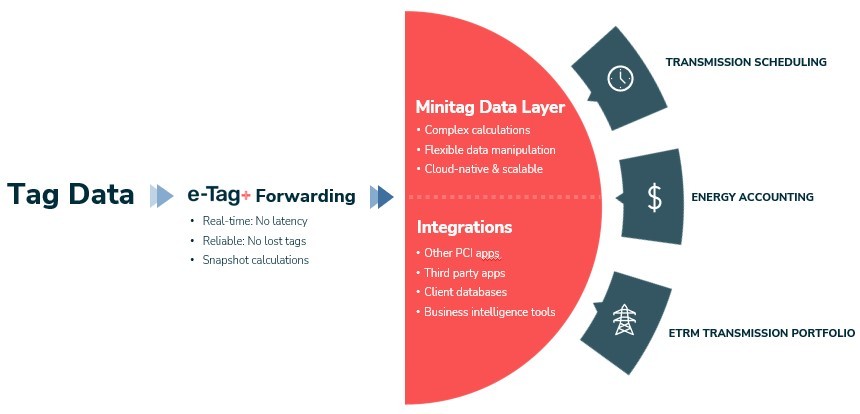Tag data is at the heart of the transmission workflow, making PCI’s e-Tag+ a critical tool for marketing and transmission operations. Since the launch of e-Tag+ in December 2021, our team has been hard at work incorporating new functionality. Our two latest enhancements are e-Tag+ Forwarding and Minitag. Together they allow customers to reliably complete complex calculations from high volumes of tag data, including real-time and day-ahead balancing positions, with no latency and no lost tags.

If your current solution isn’t cloud-native and real-time (neither PCI’s main competitors nor our legacy system are), then it’s possible you’ll find unwanted discrepancies in your tag data caused by lag. These discrepancies can make your downstream calculations unreliable. e-Tag+ Forwarding and Minitag solve these issues by eliminating lag and making it possible to complete complex calculations almost instantaneously.
What is e-Tag+ Forwarding and what does it do?
e-Tag+ Forwarding takes your e-Tag data and sends it wherever you need it to go, whether that’s to PCI modules like Minitag, your database, BI tools, or another third-party tool. So far, so simple.

L to R, back row: Jack Moon, Santiago Umbarila, Valeria Herrera, Joseph Sullivan, Nick Lopex, Kiran Hajat
L to R, front row: Jose Moreno, Saqlain Ali, Kevin Contreras
Our e-Tag+ team has created an open interface application with unmatched speed, reliability, and accuracy. The key is web-based software built with a modern modular approach. Customers using e-Tag+ Forwarding report no latency and no lost tags. That means no errors in your data, which in turn means accurate downstream calculations you can rely on and share with confidence.
Our engineers took the opportunity to incorporate a Tag Request workflow into e-Tag+ Forwarding, which enables the megawatt (MW) value to be changed after tag creation. And while they were at it, they also provided users with more transparency into their tag data by including useful visualizations and graphs that show how energy flows between entities, transmission paths, data on load, and more.
One of the most helpful places to send your tag data is, of course, to our new Minitag data layer.
What is Minitag and what does it do?
PCI’s new Minitag data layer is a place to send data where you can complete complicated calculations without impacting the original data set. Our engineers built Minitag for flexibility, enabling a much greater range of data manipulations than was previously possible and at a much greater speed.
One PCI customer ran a real-time schedule interchange after-the-fact calculation, aggregating tag data over seven days and submitting it to their ISO (CAISO) daily. That task took three to four minutes to complete. With Minitag, the same task is now completed in seconds. What’s more, the workflow for users remained precisely the same – all that changed was the technology under the hood, minimizing disruption to the team and their processes.
Snapshot Logic is another compelling business workflow enabled by Minitag. Snapshot calculations now allow PCI customers to keep both their tags as they were submitted and any updates made to those tags. Quick access to both versions removes the need for complicated manual workarounds to uncover this often hard-to-access data for settlements.
There are many more examples of business workflows that Minitag has simplified, improved, sped up, or just plain made possible, and we’re discovering new ones with customers all the time.
All this, and it scales
PCI’s e-Tag+ product, along with its enhanced functionality like e-Tag+ Forwarding and Minitag, easily scales because it’s cloud-native. So if the amount of tag data you handle dramatically increases someday, for instance, because you join a new market, PCI can scale your e-Tag services to meet your new needs with minimal disruption to your team.
Learn more about e-Tag+
- Current customers: Reach out to your sales or customer success advocate
- Non-PCI customers: Visit our Contact Us page, and we’ll connect you with an expert.







